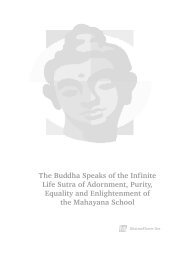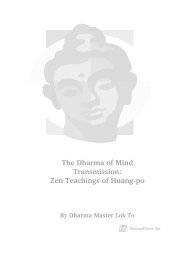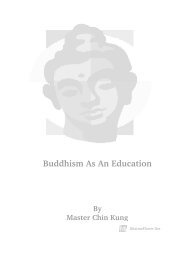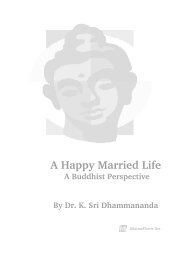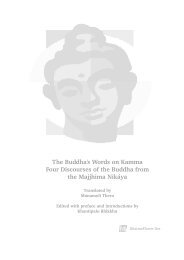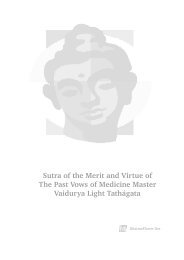Vipassana Meditation : Lectures On Insight Meditation by Venerable
Vipassana Meditation : Lectures On Insight Meditation by Venerable
Vipassana Meditation : Lectures On Insight Meditation by Venerable
You also want an ePaper? Increase the reach of your titles
YUMPU automatically turns print PDFs into web optimized ePapers that Google loves.
meditative practice. When moral conduct is purified, one never feels guilty.When one does not feel guilty, one's mind becomes steady, there<strong>by</strong>; one caneasily attain deep concentration of mind (samádhi), which, in turn, gives riseto insight wisdom (paññá).What is <strong>Vipassana</strong>?<strong>Vipassana</strong> is a Dhamma term, which is a combination of two words. 'Vi' isone word, 'passana' is the other. Here, 'vi' refers to the three characteristics ofmentality and physicality, i.e. impermanence. (anicca), un-satisfactoriness orsuffering (dukkha) and no-soul, no-self or non-ego (anattá). 'Passana' meansright understanding or realization through deep concentration, or rightunderstanding of the three characteristics of mentality (nama) and physicality(rupa). When we practice <strong>Vipassana</strong> meditation or mindfulness meditation, thepurpose is to realize, anicca, dukkha and anattá - the three characteristics ofphenomena.By realizing these three characteristics of mentality and physicality, we canexterminate every defilement such as lust, greed, desire, craving, hatred, illwill,jealousy, conceit, sloth and torpor, sorrow and worry, restlessness andremorse. Having destroyed all these defilements, we then attain deliverance orthe cessation of suffering. As long as we have any of these defilements, we aresure to experience many kinds of dukkha (suffering). Defilements (kilesas) arethe cause of suffering, therefore, when defilements have been destroyed, allkinds of suffering cease to exist.Mindfulness of the Four ElementsDuring the practice, we must observe each and every mental and physicalprocess, which is arising at the moment. In the beginning of the practice, wemust contemplate the abdominal movements as instructed <strong>by</strong> the Most<strong>Venerable</strong> Mahasi Sayadaw. Contemplation of the abdominal movements is inaccordance with the Maha Satipatthána Sutta, the Discourse on the FourFoundations of Mindfulness. In that discourse, there is a chapter concerningmindfulness of the four elements. There the Buddha teaches us to be mindfulof the four elements when they arise pathavi-dhatu - earth element, apo-dhatu- water element, tejo-dhatu - fire element and vayo-dhatu - wind element). Notonly these four elements but all mental and physical phenomena must beobserved.We must understand that the earth element is not actually the earth.Instead it refers to the true nature of the earth element. Earth element is thename given to its individual characteristics, such as hardness and softness. Thescriptures say. "Hardness and softness are the individual or specificcharacteristics of the earth element" - so when you thoroughly realize hardness12



